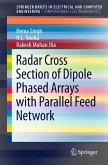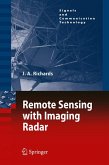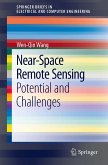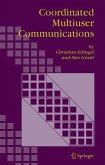73,95 €
73,95 €
inkl. MwSt.
Sofort per Download lieferbar

37 °P sammeln
73,95 €
Als Download kaufen

73,95 €
inkl. MwSt.
Sofort per Download lieferbar

37 °P sammeln
Jetzt verschenken
Alle Infos zum eBook verschenken
73,95 €
inkl. MwSt.
Sofort per Download lieferbar
Alle Infos zum eBook verschenken

37 °P sammeln
- Format: PDF
- Merkliste
- Auf die Merkliste
- Bewerten Bewerten
- Teilen
- Produkt teilen
- Produkterinnerung
- Produkterinnerung

Bitte loggen Sie sich zunächst in Ihr Kundenkonto ein oder registrieren Sie sich bei
bücher.de, um das eBook-Abo tolino select nutzen zu können.
Hier können Sie sich einloggen
Hier können Sie sich einloggen
Sie sind bereits eingeloggt. Klicken Sie auf 2. tolino select Abo, um fortzufahren.

Bitte loggen Sie sich zunächst in Ihr Kundenkonto ein oder registrieren Sie sich bei bücher.de, um das eBook-Abo tolino select nutzen zu können.
A complete and rigorous treatment of design principles for modern antennas, including chapters on signal theory and signal processing antennas, radar and polarimetry.
Contains significant new material on antennas for mobile communications to supply a complete picture of antennas for modern radiocommunications applications.
- Geräte: PC
- ohne Kopierschutz
- eBook Hilfe
- Größe: 23.74MB
Andere Kunden interessierten sich auch für
![Radar Cross Section of Dipole Phased Arrays with Parallel Feed Network (eBook, PDF) Radar Cross Section of Dipole Phased Arrays with Parallel Feed Network (eBook, PDF)]() Hema SinghRadar Cross Section of Dipole Phased Arrays with Parallel Feed Network (eBook, PDF)40,95 €
Hema SinghRadar Cross Section of Dipole Phased Arrays with Parallel Feed Network (eBook, PDF)40,95 €![Synchronization Techniques for Chaotic Communication Systems (eBook, PDF) Synchronization Techniques for Chaotic Communication Systems (eBook, PDF)]() Branislav JovicSynchronization Techniques for Chaotic Communication Systems (eBook, PDF)113,95 €
Branislav JovicSynchronization Techniques for Chaotic Communication Systems (eBook, PDF)113,95 €![Remote Sensing with Imaging Radar (eBook, PDF) Remote Sensing with Imaging Radar (eBook, PDF)]() John A. RichardsRemote Sensing with Imaging Radar (eBook, PDF)113,95 €
John A. RichardsRemote Sensing with Imaging Radar (eBook, PDF)113,95 €![Parasitic Antenna Arrays for Wireless MIMO Systems (eBook, PDF) Parasitic Antenna Arrays for Wireless MIMO Systems (eBook, PDF)]() Parasitic Antenna Arrays for Wireless MIMO Systems (eBook, PDF)113,95 €
Parasitic Antenna Arrays for Wireless MIMO Systems (eBook, PDF)113,95 €![Near-Space Remote Sensing (eBook, PDF) Near-Space Remote Sensing (eBook, PDF)]() Wen-Qin WangNear-Space Remote Sensing (eBook, PDF)40,95 €
Wen-Qin WangNear-Space Remote Sensing (eBook, PDF)40,95 €![Ideal Sequence Design in Time-Frequency Space (eBook, PDF) Ideal Sequence Design in Time-Frequency Space (eBook, PDF)]() Myoung AnIdeal Sequence Design in Time-Frequency Space (eBook, PDF)73,95 €
Myoung AnIdeal Sequence Design in Time-Frequency Space (eBook, PDF)73,95 €![Coordinated Multiuser Communications (eBook, PDF) Coordinated Multiuser Communications (eBook, PDF)]() Christian SchlegelCoordinated Multiuser Communications (eBook, PDF)73,95 €
Christian SchlegelCoordinated Multiuser Communications (eBook, PDF)73,95 €-
-
-
A complete and rigorous treatment of design principles for modern antennas, including chapters on signal theory and signal processing antennas, radar and polarimetry.
Contains significant new material on antennas for mobile communications to supply a complete picture of antennas for modern radiocommunications applications.
Contains significant new material on antennas for mobile communications to supply a complete picture of antennas for modern radiocommunications applications.
Dieser Download kann aus rechtlichen Gründen nur mit Rechnungsadresse in A, B, BG, CY, CZ, D, DK, EW, E, FIN, F, GR, HR, H, IRL, I, LT, L, LR, M, NL, PL, P, R, S, SLO, SK ausgeliefert werden.
Produktdetails
- Produktdetails
- Verlag: Springer New York
- Seitenzahl: 690
- Erscheinungstermin: 8. April 2010
- Englisch
- ISBN-13: 9780387262314
- Artikelnr.: 37287763
- Verlag: Springer New York
- Seitenzahl: 690
- Erscheinungstermin: 8. April 2010
- Englisch
- ISBN-13: 9780387262314
- Artikelnr.: 37287763
- Herstellerkennzeichnung Die Herstellerinformationen sind derzeit nicht verfügbar.
Dr. Serge Drabowitch is professor at Ecole Supérieure d'Electronique de Paris, France Dr. Hugh Griffiths is professor at University College London, UK, and Head of Department of Electronic and Electrical Engineering Dr. Albert Papiernik is professor at University of Nice, Sophia Antipolis, France Mr. Bradford Lee Smith is Senior IP Counsel at Alcatel Space Division, Paris, France
List of contributors. Foreword. Acknowledgements. Electromagnetism and antennas - a historical perspective. 1 Fundamentals of electromagnetism. 1.1 Maxwell's equations. 1.2 Power and energy. 1.3 Plane waves in linear media. Further reading. Exercises. 2 Radiation. 2.1 Plane wave spectrum. 2.2 Kirchhoff's formulation. Further reading. Exercises. 3 Antennas in transmission. 3.1 Far field radiation. 3.2 Field radiated from an antenna. 3.3 Directivity, gain, radiation pattern. Further reading. Exercises. 4 Receiving antennas. 4.1 Antenna reciprocity theorem. 4.2 Antenna effective receiving area. 4.3 Energy transmission between two antennas. 4.4 Antenna behaviour in the presence of noise. Further reading. Exercises. 5 Antennas of simple geometry. 5.1 Aperture antennas. 5.2 Wire antennas. Further reading. Exercises. 6 Printed antennas. 6.1 Introduction. 6.2 Different types of printed radiating elements. 6.3 Field analysis methods. 6.4 Input impedance, bandwidth and radiation pattern. 6.5 Low profile, wideband or multiband antennas for mobile communications and short-range applications. Further reading. Exercises. 7 Large antennas and microwave antennas. 7.1 Introduction. 7.2 Structures and applications. 7.3 Fundamental propagation laws. 7.4 Antennas as radiating apertures. Appendix 7A Deduction of the Huygens-Fresnel principle from the Kirchhoff integral. Further reading. Exercises. 8 Primary feeds. 8.1 General properties. 8.2 Horns. 8.3 Hybrid modes and corrugated horns. 9 Axially symmetric systems. 9.1 Introduction. 9.2 Symmetry properties - propagation of polarization, radiation patterns. 9.3 Principal surface. 9.4 Transfer function. 9.5 System gain.9.6 Radiation patterns. 9.7 Aberrations in axially-symmetric systems. 9.8 Axially symmetric systems considered in reception: diffraction pattern. 9.9 System considered in reception: transfer of the energy contained in the diffraction pattern to theprimary aperture. 9.10 Radiation in the Fresnel zone of a Gaussian illumination - application to the transport of energy by radiation (Goubeau's waves). Further reading. Exercises. 10 Focused systems. 10.1 Introduction. 10.2 The Cassegrain antenna. 10.3 Tracking systems. 10.4 Non axially-symmetric systems. Further reading. Exercises. 11 Arrays. 11.1 Introduction. 11.2 General structure of a phased array (examples). 11.3 Linear array theory. 11.4 Variation of gain as a function of direction. 11.5 Effects of phase quantization. 11.6 Frequency-scanned arrays. 11.7 Analogue beamforming matrices. 11.8 Further topics. Appendix 11A Comparison of linear and circular arrays. Further reading. Exercises. 12 Fundamentals of polarimetry. 12.1 Introduction. 12.2 Fully polarized waves. 12.3 Partially polarized waves. 12.4 Polarimetric representation of radar targets. 12.5 Partially polarized waves: The Mueller Matrix. 12.6 Polarizers and polarization separators for telecommunications antennas and polarimetric radars. 13 Antennas and signal theory. 13.1 Introduction. 13.2 Equivalence of an aperture and a spatial frequency filter. 13.3 Synthesis of an aperture to radiate a given radiation pattern. 13.4 Superdirective antennas.13.5 The antenna as a filter of angular signals. Further reading. Exercises. 14 Signal processing antennas. 14.1 Introduction. 14.2 Synthetic antennas in radar and sonar. 14.3 Imaging of coherent sources. 14.4 Imaging of incoherent sources. 14.5 High resolution imagery and the maximum entropy method. 14.6 Other methods of spectral estimation. 14.7 Spatial filtering. Appendix 14A Entropy and probability. Further reading. Exercises. 15 Antenna measurements. 15.1 Introduction. 15.2 Gain measurements. 15.3 Radiation pattern measurements. 15.4 Time-domain gating. 15.5 Antenna noise temperature and G/T. 15.6 Impedance and bandwidth. Further reading. Exercises. Index.
List of contributors. Foreword. Acknowledgements. Electromagnetism and antennas - a historical perspective. 1 Fundamentals of electromagnetism. 1.1 Maxwell's equations. 1.2 Power and energy. 1.3 Plane waves in linear media. Further reading. Exercises. 2 Radiation. 2.1 Plane wave spectrum. 2.2 Kirchhoff's formulation. Further reading. Exercises. 3 Antennas in transmission. 3.1 Far field radiation. 3.2 Field radiated from an antenna. 3.3 Directivity, gain, radiation pattern. Further reading. Exercises. 4 Receiving antennas. 4.1 Antenna reciprocity theorem. 4.2 Antenna effective receiving area. 4.3 Energy transmission between two antennas. 4.4 Antenna behaviour in the presence of noise. Further reading. Exercises. 5 Antennas of simple geometry. 5.1 Aperture antennas. 5.2 Wire antennas. Further reading. Exercises. 6 Printed antennas. 6.1 Introduction. 6.2 Different types of printed radiating elements. 6.3 Field analysis methods. 6.4 Input impedance, bandwidth and radiation pattern. 6.5 Low profile, wideband or multiband antennas for mobile communications and short-range applications. Further reading. Exercises. 7 Large antennas and microwave antennas. 7.1 Introduction. 7.2 Structures and applications. 7.3 Fundamental propagation laws. 7.4 Antennas as radiating apertures. Appendix 7A Deduction of the Huygens-Fresnel principle from the Kirchhoff integral. Further reading. Exercises. 8 Primary feeds. 8.1 General properties. 8.2 Horns. 8.3 Hybrid modes and corrugated horns. 9 Axially symmetric systems. 9.1 Introduction. 9.2 Symmetry properties - propagation of polarization, radiation patterns. 9.3 Principal surface. 9.4 Transfer function. 9.5 System gain.9.6 Radiation patterns. 9.7 Aberrations in axially-symmetric systems. 9.8 Axially symmetric systems considered in reception: diffraction pattern. 9.9 System considered in reception: transfer of the energy contained in the diffraction pattern to theprimary aperture. 9.10 Radiation in the Fresnel zone of a Gaussian illumination - application to the transport of energy by radiation (Goubeau's waves). Further reading. Exercises. 10 Focused systems. 10.1 Introduction. 10.2 The Cassegrain antenna. 10.3 Tracking systems. 10.4 Non axially-symmetric systems. Further reading. Exercises. 11 Arrays. 11.1 Introduction. 11.2 General structure of a phased array (examples). 11.3 Linear array theory. 11.4 Variation of gain as a function of direction. 11.5 Effects of phase quantization. 11.6 Frequency-scanned arrays. 11.7 Analogue beamforming matrices. 11.8 Further topics. Appendix 11A Comparison of linear and circular arrays. Further reading. Exercises. 12 Fundamentals of polarimetry. 12.1 Introduction. 12.2 Fully polarized waves. 12.3 Partially polarized waves. 12.4 Polarimetric representation of radar targets. 12.5 Partially polarized waves: The Mueller Matrix. 12.6 Polarizers and polarization separators for telecommunications antennas and polarimetric radars. 13 Antennas and signal theory. 13.1 Introduction. 13.2 Equivalence of an aperture and a spatial frequency filter. 13.3 Synthesis of an aperture to radiate a given radiation pattern. 13.4 Superdirective antennas.13.5 The antenna as a filter of angular signals. Further reading. Exercises. 14 Signal processing antennas. 14.1 Introduction. 14.2 Synthetic antennas in radar and sonar. 14.3 Imaging of coherent sources. 14.4 Imaging of incoherent sources. 14.5 High resolution imagery and the maximum entropy method. 14.6 Other methods of spectral estimation. 14.7 Spatial filtering. Appendix 14A Entropy and probability. Further reading. Exercises. 15 Antenna measurements. 15.1 Introduction. 15.2 Gain measurements. 15.3 Radiation pattern measurements. 15.4 Time-domain gating. 15.5 Antenna noise temperature and G/T. 15.6 Impedance and bandwidth. Further reading. Exercises. Index.







